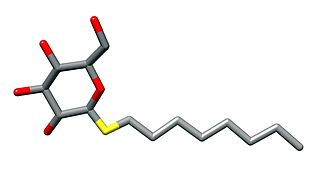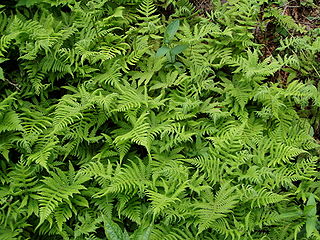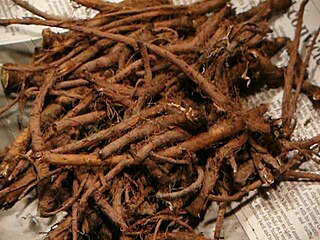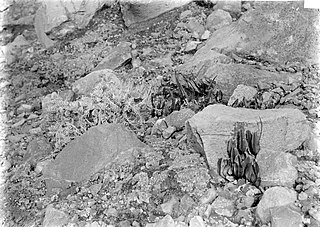A glucoside is a glycoside that is chemically derived from glucose. Glucosides are common in plants, but rare in animals. Glucose is produced when a glucoside is hydrolysed by purely chemical means, or decomposed by fermentation or enzymes.

Pteris (brake) is a genus of about 300 species of ferns in the subfamily Pteridoideae of the family Pteridaceae. They are native to tropical and subtropical regions, southward to New Zealand, Australia, and South Africa, north to Japan and North America. 78 species are found in China. Some species of Pteris have considerable economic and ecological value, such as Pteris multifida, Pteris ensiformis, Pteris vittata can be used for ornamental purposes; as a hyperaccumulator, Pteris multifida and Pteris vittata can be used to control soil pollution.

n-Octyl β-d-thioglucopyranoside is a mild nonionic detergent that is used for cell lysis or to solubilise membrane proteins without denaturing them. This is particularly of use in order to crystallise them or to reconstitute them into lipid bilayers. It has a critical micelle concentration of 9 mM.

Pteridaceae is a family of ferns in the order Polypodiales, including some 1150 known species in ca 45 genera, divided over five subfamilies. The family includes four groups of genera that are sometimes recognized as separate families: the adiantoid, cheilanthoid, pteridoid, and hemionitidoid ferns. Relationships among these groups remain unclear, and although some recent genetic analyses of the Pteridales suggest that neither the family Pteridaceae nor the major groups within it are all monophyletic, as yet these analyses are insufficiently comprehensive and robust to provide good support for a revision of the order at the family level.

In organic chemistry, benzoyl is the functional group with the formula −COC6H5 and structure −C(=O)−C6H5. It can be viewed as benzaldehyde missing one hydrogen. The benzoyl group has a mass of 105 amu.

Rosmarinic acid, named after rosemary, is a polyphenol constituent of many culinary herbs, including rosemary, perilla, sage, mint, and basil.

Phegopteris connectilis, commonly known as long beech fern, northern beech fern, and narrow beech fern, is a species of clonal fern native to forests of the Northern Hemisphere. It grows to heights of 10–50 cm.

Dandelion 'coffee' is a tisane made from the root of the dandelion plant. The roasted dandelion root pieces and the beverage have some resemblance to coffee in appearance and taste, and it is thus commonly considered a coffee substitute. Dandelion root is used for both medicinal and culinary purposes and is thought to be a detoxifying herb.

Cucurbitacins are a class of biochemical compounds that some plants – notably members of the pumpkin and gourd family, Cucurbitaceae – produce and which function as a defense against herbivores. Cucurbitacins and their derivatives have also been found in many other plant families, in some mushrooms and even in some marine mollusks.

Taxifolin (5,7,3',4'-flavan-on-ol), also known as dihydroquercetin, belongs to the subclass flavanonols in the flavonoids, which in turn is a class of polyphenols. It is extracted from plants such as Siberian larch and milk thistle.

Selliguea feei is a fern belonging to the genus Selliguea in the family Polypodiaceae. This fern can be collected in Indonesia. The species name feei commemorates the botanist Antoine Laurent Apollinaire Fée.

Pteris tremula, commonly known as Australian brake, tender brake, tender brakefern, shaking brake is a fern species of the family Pteridaceae native to sheltered areas and forests in eastern Australia and New Zealand. It has pale green, lacy fronds of up to 2 meters in length, with an erect, tufted rhizome that is covered with narrow brown scales. It is fast-growing and easy to grow in cultivation, but can become weedy.

Benzoyl-beta-d-glucoside is a benzoyl glucoside, a natural substance that can be found in Pteris ensiformis.

Hispidin is a natural substance. It can also be synthesized.

Kaempferol 7-O-glucoside is a flavonol glucoside. It can be found in Smilax china, and in the fern Asplenium rhizophyllum, and its hybrid descendants, as part of a complex with caffeic acid.

Smilax china is a climbing plant species in the genus Smilax. It is native to China, Korea, Taiwan, Japan, Philippines, Vietnam, Thailand, Myanmar, and India. It also known as china root, china-root, or chinaroot, as is the related Smilax glabra.

Terminalia myriocarpa, the East Indian almond, is a tree species in the genus Terminalia found in Southeast Asia.

Catechin-7-O-glucoside is a flavan-3-ol glycoside formed from catechin.
Alpinia nigra is a medium-sized herb belonging to the ginger family. The rhizome is well known in many Asian cultures as a medicinal and culinary item. In many Asian tribal communities it is a part of the diet along with rice.

Echinops echinatus, the Indian globe thistle, commonly known as Usnakantaka, is a species of globe thistle, found in India, Pakistan, and Sri Lanka. Indian globe thistle is an erect branched herb about 100 cm high. It has short, stout stems, branching from the base, covered with white cottony hair. Alternately arranged oblong, deeply pinnatifid leaves are 7–12 cm long. Flower heads occur in solitary white spherical balls, 3–5 cm across. Petals of the tiny white disc florets are 5 mm long. Flowers are surrounded by straight, strong, white bristles. Often misidentified with Silybum marianum (L.) Gaertner, it is colloquially known as Camel's thistle.



















